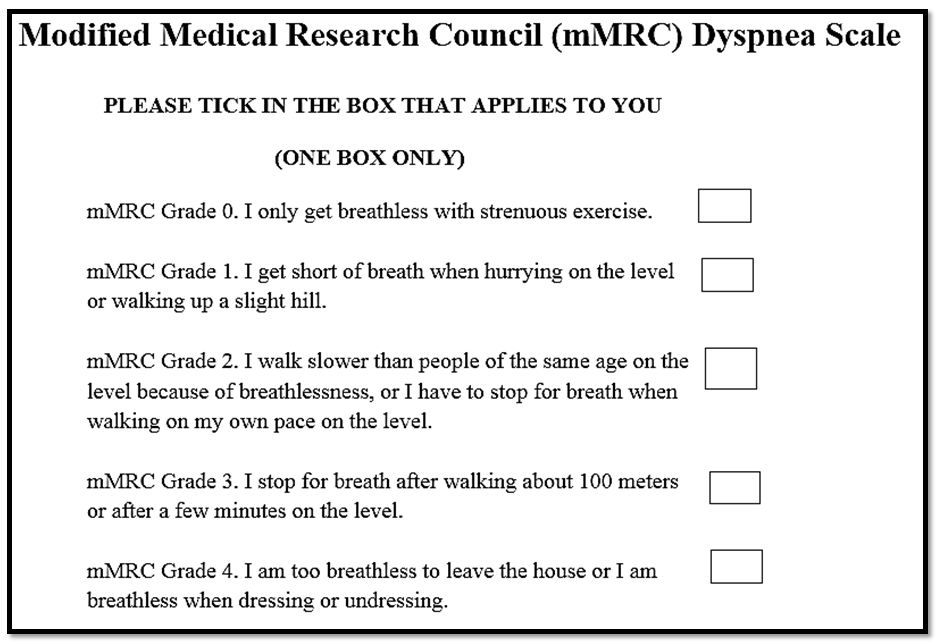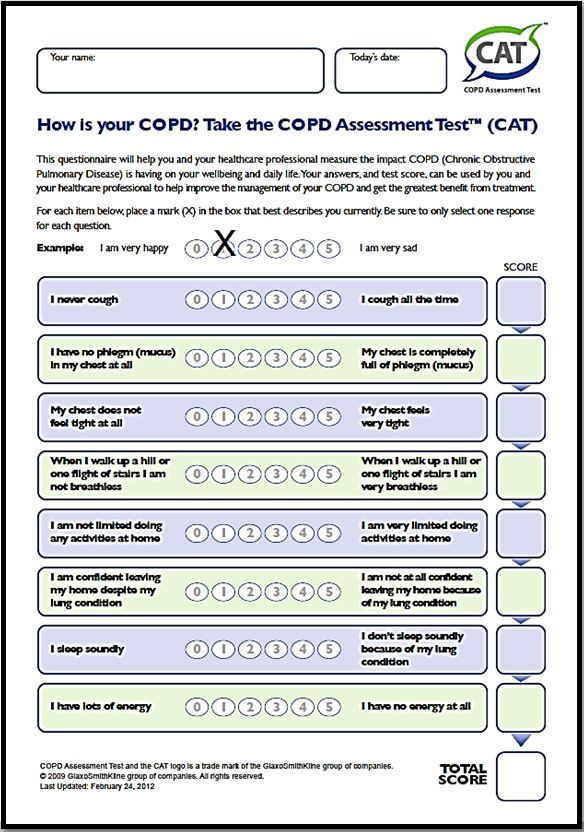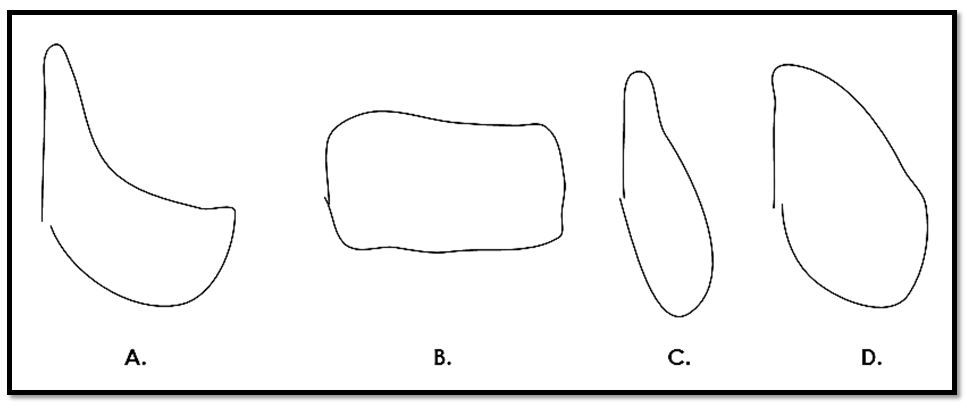A COPD Pop Quiz: 5 Tricky Questions
Try these 5 questions written by a pulmonologist and based on updates to the GOLD guidelines on how to classify and manage COPD.
Figure 1. (Please click to enlarge) mMRC dyspnea scale

Figure 2. (Please click to enlarge) ©2009 GlaxoSmithKline group of companies.

Figure 3. (Please click to enlarge) Spirometry tracings

1. Which of the following treatments would be beneficial in the treatment of a COPD exacerbation?A. Nebulized magnesium
B. Chest physiotherapy
C. Mucoactive agents
D. None of the above
Please click below for answer, discussion, and next question.
Answer: D. None of the above.
Nebulized magnesium is useful for patients with a severe asthma exacerbation in the emegency department, but not for COPD. Chest physiotherapy, while it may be useful for bronchiectasis, has not been shown to be helpful in regular COPD, and may exacerbate bronchospasm. Similarly, there is no good evidence for the use of mucoactive agents, and many of these can also exacerbate bronchospasm.
*****************************************
Mary has just been diagnosed with COPD. She notes severe dyspnea with minimal activity, such as washing up in the morning or trying to cook dinner. She has been hospitalized once for COPD within the past year, and has been on antibiotics for an exacerbation 3 times. Her FEV1/FVC ratio is 55%, and her FEV1 is 65% of predicted.
2. According to the GOLD (Global Initiative for Chronic Obstructive Lung Disease) guidelines, what stage is Mary’s COPD?
A. Stage A
B. Stage B
C. Stage C
D. Stage D
Please click below for answer, discussion, and next question.
Answer: D. Mary is GOLD stage D.
GOLD guidelines now classify COPD stage based on symptoms and exacerbations, as shown here:
Mary has had one hospitalization and 3 exacerbations, so we know that she is either stage C or D. But how can we tell if she has high symptoms according to the guidelines? Please see the MMRC (Modified Medical Research Council) dyspnea scale (Figure 1, above) and the CAT (COPD Assessment Test) (Figure 2, at right).
You are probably saying to yourself, this is ridiculous. I can’t memorize these two forms. There is a simpler way.
Since the guidelines state that patients have high symptoms if they are in mMRC class 2 or higher, all you have to remember is that if patients state they have dyspnea walking on level ground, or can’t walk as fast as their friends who are the same age, then they are considered highly symptomatic. So, Mary is stage D. Note that in the newest iteration of the GOLD Guidelines, lung function is no longer used to define stage.
*****************************************
3. What would be the preferred treatment regimen for Mary, assuming that she is already using a short- acting beta agonist as a rescue medication?
A. Long acting muscarinic inhaler (LAMA)
B. Long acting beta agonist/inhaled corticosteroid (LABA/ICS)
C. LAMA/LABA
D. LAMA/LABA/ICS
Please click below for answer and next question.
Answer: C. LAMA/LABA would be the preferred medication.
The new combination inhalers LAMA/LABAs have been found to be superior in symptom control, lung function improvement, and exacerbations to LAMA alone, with a similar safety profile. They were also shown to outperform LABA/ICS in a large study of COPD patients. They are now considered the first-choice option for stage D, with LAMA/LABA and LAMA/LABA/ICS as alternatives treatments.
*****************************************
4. What course of steroids would NOT be appropriate to treat an exacerbation of COPD, according to the latest guidelines?
A. Medrol 28 mg for 7 days
B. Prednisone 40 mg for 5 days
C. Prednisone 40 mg with a taper over 10 days
D. Prednisone 60 mg with a taper over 3 weeks
Please click below for answer and next question.
Answer: D. Prednisone 60 mg with a taper over 3 weeks would NOT be appropriate to treat an exacerbation.
Two guidelines have recently been published about exacerbations, the GOLD guidelines and a combination ERS/ATS (European Respiratory Society/American Thoracic Society) statement. Both guidelines recognize that the quality of the data regarding dose and duration of oral steroids for an outpatient exacerbation is poor. The GOLD guidelines suggest prednisone at a dose of 30-40 mg daily or equivalent for 5 days. The ERS/ATS statement recommends a course of oral steroids at an unspecified dose for 9-14 days.
Thus, only option D, which is prednisone for a period of 3 weeks, is inconsistent with either guideline.
*****************************************
5. Please examine the flow volume tracings in Figure 3, below. Which tracing is consistent with COPD?
Please click below for answer and resources.
Answer: Curve (A) is consistent with a diagnosis of COPD.
Note the expiratory (top) part of the loop is concave shaped; ie, there is a marked reduction of flows during expiration because of dynamic collapse of the airways. Curve B would be seen in a fixed upper airway obstruction, such as a laryngeal tumor. Curve C, which is markedly narrowed, would be seen in a restrictive lung disease. Curve D is normal.
Works Cited
Snow V, Lascher S, Mottur-Pilson C, Joint Expert Panel on Chronic Obstructive Pulmonary Disease of the American College of Chest Physicians and the American College of Physicians-American Society of Internal Medicine. Evidence base for management of acute exacerbations of chronic obstructive pulmonary disease. Ann Intern Med. 2001;134:595.
Bach PB, Brown C, Gelfand SE, et al. Management of acute exacerbations of chronic obstructive pulmonary disease: a summary and appraisal of published evidence. Ann Intern Med. 2001;134:600.
Edwards L, Shirtcliffe P, Wadsworth K, et al. Use of nebulised magnesium sulphate as an adjuvant in the treatment of acute exacerbations of COPD in adults: a randomised double-blind placebo-controlled trial. Thorax. 2013; 68:338.
Global Strategy for the Diagnosis, Management and Prevention of COPD, Global Initiative for Chronic Obstructive Lung Disease (GOLD) 2017. http://www.goldcopd.org (Accessed on March 1, 2018)
Papi A, Rabe KF, Rigau D, et al. Management of COPD exacerbations: a European Respiratory Society/American Thoracic Society guideline. Eur Respir J. 2017;49:1600791 [https://doi.org/10.1183/13993003.00791-2016].
Wedzicha JA, Banerji D, Chapman KR, et al. Indacaterol–glycopyrronium versus salmeterol–fluticasone for COPD. N Engl J Med 2016.374 (2016): 2222-2234.